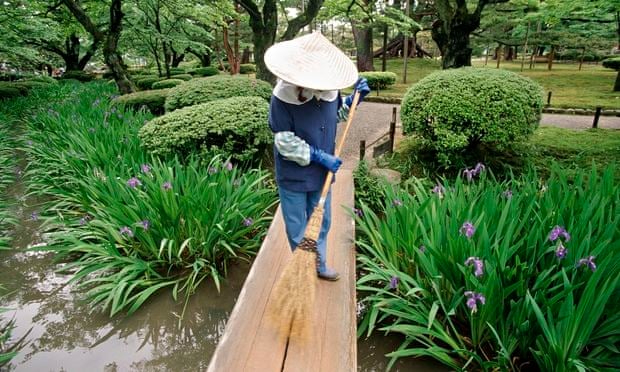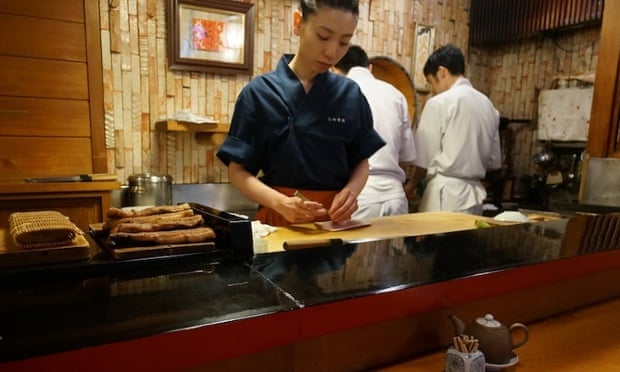
A shinkansen bullet train on a test run glides in alongside us, slowing to a halt amid a symphony of mechanical exhalations. Beside me, Noriko Iwata of the local tourist board bristles with excitement. “The shinkansen is a very, very big thing for Kanazawa,” she says with a beaming smile. “When ticket sales opened for the first journey in March, they sold out within 25 seconds.”
The Japanese love anything new, of course, but this also shows their affection for “Little Kyoto”, as this city on the north coast of Honshu is known. Even before the new shinkansen line opened – slashing journey times from Tokyo by two hours to 2½ hours – domestic tourism had increased five-fold over the previous few months, such was the renewed interest in Kanazawa, and foreign tourists are expected to follow.
There’s no sign of Japan’s “ailing” economy here: the Hokuriku line cost 1.6 trillion yen (over £9 billion), and the pillars supporting the station roof are each ringed by a broad pelmet of gold leaf. “Every pillar uses 20,000 sheets of gold leaf,” Noriko tells me.
How many pillars are there in all? “Sixty.” That’s … an awful lot of gold.
While Tokyo and Kyoto are going to remain the top choices for first-time visitors toJapan, Kanazawa deserves to join second-tier destinations such as Sapporo, Nara, Osaka, Okinawa and Himeji. And with mountains, beaches and the rugged, rural Noto peninsula 30 minutes away, it works as a summer or winter destination.

Traditional sights are many, and of the highest quality: it has one of the top three official Great Gardens of Japan, the 17th-century Kenrokuen. On my visit, many of its 9,000 trees are trussed up in the yukizuri style to support their branches against the heavy snows of winter. Nearby is the city’s 16th-century castle (mostly reconstructed yet still impressive), and though the ninja temple, Myoryuji, has no connection whatsoever with the ninja, it is still fascinating, with its trap doors, hidden floors and dedicated hari-kiri room. The circular 21st Century Museum of Contemporary Art, designed by Pritzker prize-winning architect studio SANAA, is genuinely world class, and there is a unique food scene, with – arguably – the best sushi restaurants in the country.
My French friend Mathilde, who lives in the city, accompanies me to two of them during my stay. The first is Shinosuke, a 10 minute drive west of the city centre, whose chef is a disciple of Kazuo Morita, considered by some as the greatest sushi chef. It is sublime but our favourite of the two is Otomezushi (+81 76 231 7447), in the more central nightlife district of Korinbo, with a less ascetic atmosphere and more sharply seasoned rice. Highlights include the gasu ebi, a super-sweet prawn too delicate to transport and thus almost impossible to find outside the region, and nodoguro, which Mathilde, a fluent Japanese speaker, translates as black-throated gnomefish (though I prefer the Latin name: scombrops boops). A meal at either costs around £60, but there’s fantastic takeaway sushi at the lively, 280-year-old Omi-cho market for about £10.

The gold leaf work I saw at the station is one of several traditional crafts for which Kanazawa is famed. At Hazuka, a gold-leaf artisan boutique in one of the town’s tastefully preserved geisha quarters, I watch, transfixed, as a member of staff demonstrates how to work with these micro-thin sheets of gold. Too clingy to touch, the leaf ripples like water as she gently blows it into place.
While Kyoto can sometimes seem a little stagey, with fake geishas roaming the Gion district like costumed characters, Kanazawa’s geisha and samurai districts are more traditional. There are still around 40 geisha in the city, and samurai families remain here too.
“That authentic, local feeling is very strong,” explains Chris Wiggin during a sake-fuelled izakaya-crawl one night. The 27-year-old American married a local woman and now lives in the city. How are Kanazawans perceived by the rest of Japan, I wonder? “They are shy, quiet, not so outgoing, but once you get to know them, they really open up. When I first came here, I felt like I was in the middle of nowhere, which I rather liked, actually. And the food is amazing.”
Amazing indeed. “It’s a challenge for you,” says the grinning chef at my hotel breakfast buffet the next morning, when I ask about a small pot of what looks like crumbs. It is fugu roe. “We salt it for four hours so all the poison has gone away. You won’t die!” he adds. A basic requirement of breakfast, I’d have thought, but I try it, and am rather taken by this pungent condiment.
I take the normal train back to Tokyo the next day. It has to be one of the most beautiful train journeys in the world, skirting the coast before turning inland to tackle the Japanese Alps. The views are worth the ride alone, but Kanazawa offers much more.
• For more information on Kanazawa, go to seejapan.co.uk. Flights were provided by Japan Airlines (0344 856 9778, uk.jal.com), which flies from Heathrow to various Japanese cities from £680 return
Contributed by Michael Booth
Follow us on Twitter: @TraveloreReport
No comments:
Post a Comment